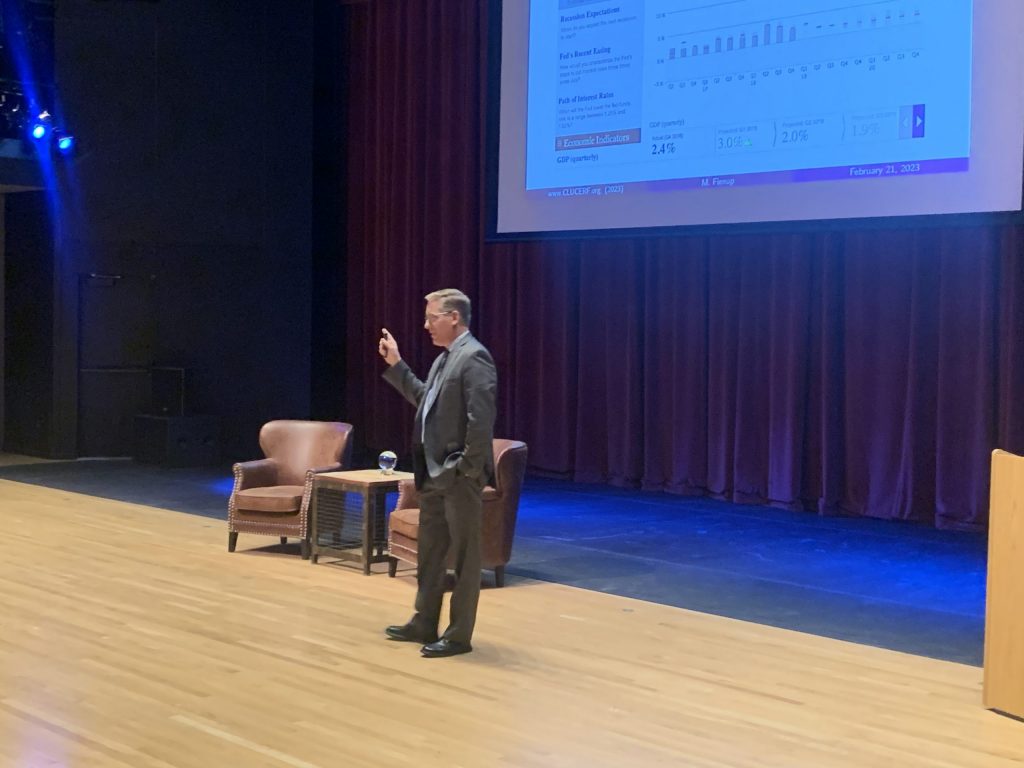Affordable housing will be key for economic recovery in Ventura County
IN THIS ARTICLE
- Economy Topic
- Mike Harris Author
By Mike Harris Wednesday, February 22nd, 2023

While Ventura County is facing a slow post-pandemic economic recovery, there‘s reason to be more optimistic about the long term, according to the Center for Economic Research and Forecasting at Cal Lutheran.
“There’s a fundamental change in attitudes (by cities) about growth – that we can achieve balance between jobs, housing and the environment to preserve the quality of life,” Matthew Fienup, executive director of the center at California Lutheran University in Thousand Oaks, said at its annual economic forecast event Feb. 21.
“That means that Ventura County’s economic future is bright,” he said at the program at the Scheer Forum Theater in the Thousand Oaks Civic Arts Plaza.
The county will see slower growth than neighboring counties in the short term due in large part to its weak pre-pandemic economy, Fienup told the packed house.
But the medium and long-term forecast is a rosier one, he said.
City officials throughout the county now understand “that growth is a necessary ingredient to quality of life,” he told The Business Times following the event.
“Twenty years ago, we thought there was a tradeoff between growth and quality of life,” he said. “Now, there’s a widespread recognition that no, those two go hand in hand.”
For instance, he said, policymakers now realize that more housing is needed in the county to attract businesses and house their employees.
“An environment where we don’t house our workforce means people having to commute in from outside the county,” Fienup said. “It means young people are leaving the county to go to other regions to seek opportunities, to start households, to build their careers. And that’s our loss.”
He noted that in video presentations at the event, Thousand Oaks City Manager Drew Powers and Simi Valley City Manager Brian Gabler touted that more than 2,000 housing units in their cities have been green-lighted in recent years.
“And that’s just two” of the county’s 10 cities, Fienup said. “So that’s all really optimistic.”
Another component of the change in attitude by city officials is that “we’re rolling out the red carpet to attract new businesses and asking incumbent businesses, ‘what do we need to do keep you here?’” he said.
Fienup said he couldn’t pinpoint when the economic picture in the county will turn the corner.
“I don’t have a great answer,” he said. “Obviously when you permit 1,000 homes today, I don’t know when shovels actually go into the ground.”
But he said he would certainly expect things to improve within the decade.
Released at the Feb. 21 event, the center’s annual economic forecast report focused more on its prognosis that the county is facing a long post-pandemic recovery.
The forecast sees “slow growth in the economy, population and labor force – slower relative to the U.S., California and neighboring counties.
“Like the U.S., it will experience a stagflation era, where growth is positive but low, and inflation remains stubbornly high,” according to the report’s highlights authored by Dan Hamilton, the center’s director of economics.
But – on the plus side – “our baseline forecast is not that Ventura County will experience a recession,” Hamilton’s highlights say.
CERF maintains that the county’s growth will be strong in low-paying sectors, but weak in high-value-added sectors.
Through 2025, the county’s GDP will not only lag that of its own history and that of its peers, but its economic growth will also lag the rate of its job creation, the report predicts.
The county’s economic growth estimate for 2016 through 2019 was 0.7%, compared to 2.2% for Los Angeles County, 2.4% for Orange and San Diego counties and 2.7% for Riverside County, according to the center.
Ventura County’s economy peaked in 2007. The most recent date indicates it has decreased by 12.3%.
The number of jobs in Ventura County hit its high point in 2019 at 336,800, Fienup said. The current number is 332,047.
The county’s population peaked in 2015 at 850,038 people. It presently stands at 829,764 people, he said.
The county’s civilian labor force was at its high point in 2012 with 433,700 people. The current civilian labor force is 411,583 people.
“We’ve always held that weak economies, in general, are less able to absorb unexpected shocks” like the pandemic, Fienup said earlier in February.
He told the Business Times after the Feb. 21 event that development-restrictive Save Open Space and Agricultural Resource laws and the “extraordinary anti-growth attitudes of the late 1990s and early 2000s” were the drivers of the prolonged period of economic weakness that the county endured prior to the pandemic.
He said that while attitudes about growth have begun to change, “the county’s economy is still encumbered by SOAR.”
The county’s population and civilian labor force have decreased in large part to the high cost of living and lack of affordable housing there.
According to the National Association of Realtors, on an income-adjusted basis, the Oxnard/Thousand Oaks/Ventura region is the third least affordable metro area in the nation to live in, Fienup noted.
Company executives in Ventura County say they can’t attract and retain talent because of how expensive housing is there, he said.
One bright spot, the report notes, is that Ventura County’s economy weathered the pandemic better than other localities.
“As CERF economists noted a year ago, our county’s leaders led the state in efforts to re-open small businesses and schools earlier and to keep these establishments open longer in the face of subsequent waves of COVID transmission,” the report says.
Prior to the economic forecast presentations, Kimberley Strassel, a member of the Wall Street Journal’s editorial board, spoke on the “unprecedented” bitter partisanship in Washington D.C., which she labeled the “new abnormal.”









